129 3rd Street
Granby
CO 80446
Spring Potlatch – Saturday, March 26, 6 pm – 8:30 pm
at Granby Community Center, 129 3rd Street, Granby, CO 80446
FREE, $5 suggested donation
GCHA is proud to present our Spring Potlatch, previously known as our Mid-Winter Potluck. A potlatch is a sharing feast – like a potluck – practiced by most all native groups of the Americas for millennium. Sometimes special drinks like chiche corn beer, hot chocolate, or pulque was served!
To our Spring Potlatch, please bring a dish to share, from appetizers to desserts, and GCHA is supplying drinks and a fabulous program on Native American themes.
We are using the term Potlatch – instead of potluck — to honor our program, which features two experts on Native American prehistory and art. One is Dr. Marcel Kornfeld, an eminent scholar and archaeologist from the Anthropology Department at University of Wyoming. The other is Cliffton Lomayaktewa, a traditional Hopi wood carver and maker of kachina dolls, who now resides in Granby.
GCHA is grateful to board member, Tyson Arnold, for arranging this fantastic program with his friends and mentors. At the potlatch, Tyson will introduce our special guests.
Dr. Marcel Kornfeld is a Professor of Archaeology (BA 1974, Uni. of New Mexico; MA 1982 Uni. of Wyoming; PhD1994, Uni. of Massachusetts). His research interests are Paleoindian sites and human adaptations to Plains, Foothills, and Mountainous areas of the western United States. He has extensively explored Middle Park and Grand County, oftentimes with Tyson Arnold by his side.
The subject of Marcel’s talk is Middle Park archaeology, as presented in his prize-winning book, The First Rocky Mountaineers, University of Utah Press, 2013, which will be available for purchase and signing.
As shown in GCHA’s Ute exhibit at Cozens Ranch Museum, Middle Park was occupied for centuries by the Ute people. In his talk and book, The First Rocky Mountaineers is a prehistory of the earliest people of our region at the conclusion of the Ice Age.
The Utes and their predecessors lived and thrived for 12,000 years in this high mountain setting, an environment that demanded unique adaptive strategies because of cold weather conditions.
People of Middle Park coped with some of the most extreme conditions of any prehistoric population in North America, dealing with the stressors of high elevations and low temperatures by intensifying food acquisition, constructing shelters, and tailoring sophisticated warm clothing.
The archaeological record of these early Coloradans provides a wealth of information about lifeways in the Rocky Mountain high country. Dr. Kornfeld’s talk will interpret these early lifeways and their unique adaptations for a general audience.
At the Spring Potlatch, GCHA is honored to introduce Cliffton Lomayaktewa and his kachina carvings for sale and raffle. Please join us to visit with Cliffton to see his renowned carvings and a carving demonstration.
Cliffton was born in 1971 at Hopi Pueblo to the Katsina/Parrot Clan. He grew up at Old Oraibi on the Hopi reservation, in northern Arizona. Cliffton is well known for his “Old Style” carvings.
Traditionally, katsina dolls are used as teaching tools, although now they are widely collected as valuable art. A search of eBay finds that Cliffton’s katsinam sell from $100 to over $500, due to his fine skills honed on the pueblo.
Called kachinas, katsina, or katsinam (plural), Cliffton’s traditional dolls are carved from soft cottonwood and painted with traditional, natural paints made from ground plants and minerals. They are the carved representations of the Katsinam, the spirit messengers of the universe. The Katsinam come to Hopi in the form of clouds, which bear life-giving rain.
Both the deeper meaning of a katsina doll and the material from which it is carved – the root of the cottonwood tree – is unchanged through the centuries, thanks to traditional carvers such as Cliffton.
Some of Cliffton’s katsina dolls are created for the public and are considered an artform. Still, the ancient spirituality of the katsina religion endures and is nurtured in Hopi communities, and by carvers like Cliffton.
As a youth, Cliffton spent much time with his grandparents who instilled in him traditional Hopi values, culture and the arts. He later moved to his wife’s village at First Mesa, also on Hopi lands. Now, for over a year, Cliffton has made Granby his home where he carves his Old Style katsinam.
Says Cliffton, ”I have been making Old Style Katsinas for years. I like the Old Styles because of how they were made traditionally, the carving style and coloring. I am glad the demand of Old Style is coming back. This gives me a chance to keep the old traditions alive. There are only a few Old Style carvers, so I am happy to be one of the few.”
Directions: From the main street in Granby (Agate Ave), turn uphill on 3rd Street. Just past the stop sign, on the left hand side, is the Granby Community Center.

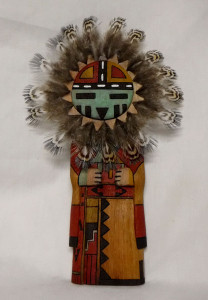
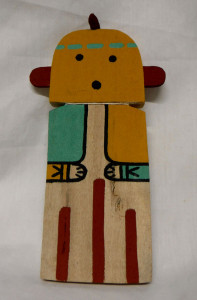

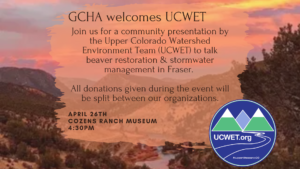
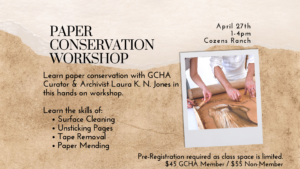

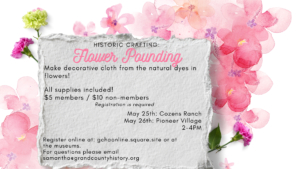
 >> Join GCHA Today! Choose from a variety of membership levels.
>> Join GCHA Today! Choose from a variety of membership levels. >> Sign-up for the Email Newsletter & get the latest news about events, museum exhibits & more!
>> Sign-up for the Email Newsletter & get the latest news about events, museum exhibits & more!